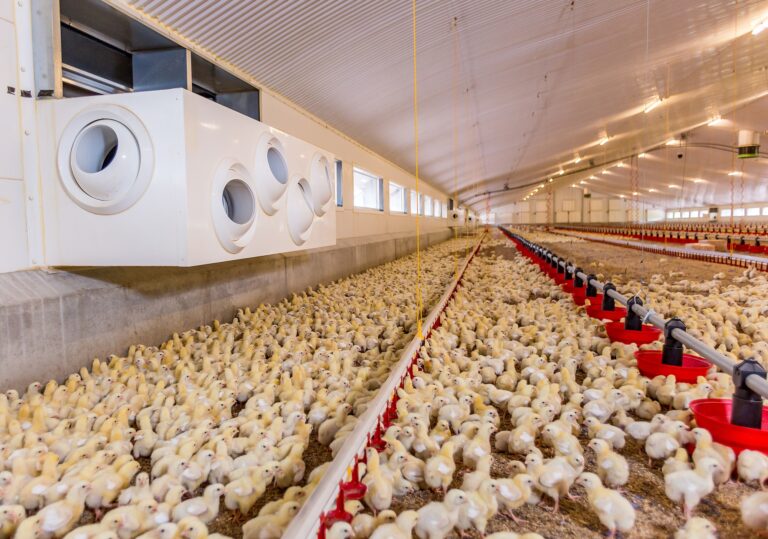Ammonia can have a significant impact on human health and the environment, and it’s one of the major air pollutants in the UK. So what steps are being taken by the poultry industry to mitigate this issue?
By Karen Wright
Odour complaints are just the tip of the iceberg when it comes to ammonia emissions from poultry units. They can also be associated health risks for humans and for poultry, says Cargill’s poultry specialist Daniel Palcu.
“It can also impact on the environment. It acidifies soil and fresh water, and this can negatively influence the balance of plant species. The restoration of this balance can be costly and can also take many years,” he adds.
Another factor for producers to consider is that high levels of ammonia in a poultry unit are detrimental to poultry health and are also a sign that feed conversion is less efficient. Nitrogen is excreted via the bird’s kidney, as uric acid, rather than being used for growth. So, tackling ammonia emissions can also be valuable in improving feed conversion efficiency.
“In poultry housing, the recommended ammonia levels are below 10ppm. Levels above that will damage the bird’s lung surface and if they’re above 20ppm then this will increase susceptibility to respiratory diseases. Levels above 25ppm may reduce growth in certain conditions,” he explains.
In the UK, Defra has ruled that ammonia levels in the UK should be reduced by 8% by 2020 and by 16% by 2030, from 2015 levels. At the moment, 88% of the total ammonia emissions come from agriculture, and it is estimated that the poultry industry is responsible for 15% of these. So, there is work to do.
In 2018, Defra’s Air Quality and Industrial Emissions team released a new guidance document for reducing ammonia emissions – Code of Good Agricultural Practice (COGAP).
“One of the key points in the ammonia reduction strategy refers to animal nutrition and the importance of professionally formulated diets,” says Palcu. “These can have a significant impact in reducing ammonia levels. Precise formulation and using specific feed additives can promote better nutrient utilisation and minimise nitrogen excretion.
“It’s now possible to take this a step further with plant-based or ‘phytogenic’ work. This has led to the development of phytogenic products, for broiler and layer diets, that can improve gut health, reduce ammonia emissions and, therefore, improve feed efficiency. They’re good for the bird, good for the environment and, ultimately, good for the business.”
These phytogenic feed additives, which are now used in specialist feed additives in poultry diets, are a result of the discovery and testing of a wide range of active molecules. They have an interesting and complex mode of action and offer good results in animal production and health.
Research into phytogenics has increased significantly during the past few years. The poultry industry faces numerous challenges, going forward, including antibiotic reduction, sustainability and the environment. “The use of natural products seems to be, in some instances, the logical solution,” adds Palcu.
Cargill has been working on the development of phytogenic products through its partnership with Austrian-based Delacon; Delacon is well known globally for its work in plant-based feed additives.
It has found that saponins, a class of plant secondary metabolites found in a commercial phytogenic product, help to reduce ammonia formation by inhibiting enzymes involved in urea degradation and also by directly binding ammonia. “The nitrogen excretion is, therefore, reduced and this leads to less substrate for ammonia formation.”
In eight broiler and layer trials, where these saponins were included in the diet within the poultry feed additive Biostrong 510, ammonia emissions were reduced by 32%, with results ranging from 18% to 65% depending on the season.. Palcu adds that these results were linked with a significant reduction of wet litter (25%).
These trials compared the performance of 240 male Cobb 500 birds with a control group. Both were fed on a corn and soy diet with 22.9% crude protein as a starter diet reducing to 20.8% crude protein in the finishing stages, with one group fed the diet that included Biostrong 510.
A trial comparing the use of Biostrong 510 was also carried out in the UK in 2018 in a challenged environment. The performance, from zero to 35 days of age, of replicate groups of Ross 308 male birds fed on a control diet and one with Biostrong 510 were compared in used and clean litter.
“The work revealed a significant increase in liveweight, feed intake, and FCR in the birds fed on a diet that included Biostrong 510 at the rate of 150g/t. These results, together with the ammonia reducing effect, proves the efficacy of this specific phytogenic product,” he adds.


